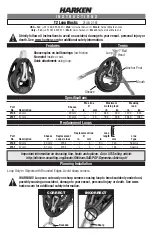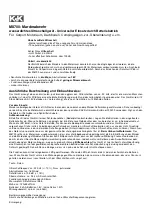
Operation
16 — English
Fillcontrol Plus Compact — 03.05.2022 - Rev. D
7.2.1
Entering the minimum operating pressure in the controller
Enter the value for "P0" minimum operating pressure into the controller.
1
Display
4
Arrow keys
2
"Auto" LED
5
Mode key
3
Status LEDs (I-IV)
1.
Remove the black plastic cover of the device.
–
Press the catches on both sides of the plastic cover and pull the cover
upward.
2.
Insert the plug into the jack socket.
3.
Fit the plastic cover.
–
The catches on both sides of the plastic cover must latch.
4.
Plug in the power supply.
–
After approximately. 4 seconds, the system pressure is shown on the
display.
–
The "Auto" LED (2) flashes green as a visual signal.
5.
Press the Mode key (5) for 4 seconds.
–
The "I" LED (3) flashes in 0.5 second rhythm as a visual signal.
–
The factory-set default value for the "P
0
" minimum operating
pressure is displayed.
6.
Press the arrow keys (4) to set the required "P
0
" minimum operating
pressure.
7.
Then press again the Mode key (5) to confirm your input of the "P
0
"
minimum operating pressure.
The "P
0
" minimum pressure is entered.
Note!
If necessary, press the Mode key (5) to activate the automatic make-up
for 3 seconds.
•
Upon activation, the "Auto" LED will illuminate in continuous
green.
7.2.2
Adjust the pressure reducer
The pressure reducer is factory-set to a default value of 3.0 bar.
You must use the pressure reducer to set the setting pressure for the device.
–
Minimum setting pressure: Minimum operating pressure p
0
+ 0.5 bar
–
Maximum setting pressure: Actuating pressure of the safety relief valve
from the facility system p
sv
– 0.5 bar.
Set the pressure reducer as follows:
1.
Remove the insulation of the device.
2.
Ensure that the inlet pressure is higher by at least 1.3 bar than the desired
"p
0
" minimum operating pressure.
3.
Unlock the pressure setting knob by pulling it downward.
4.
Set the required pressure.
–
You increase the outlet pressure by turning the pressure setting knob
clockwise. Turing the knob counter-clockwise reduces the pressure
setting.
5.
Install an inspection pressure gauge.
6.
Directly read the selected setting at the inspection pressure gauge,
7.
After you have set the required pressure, push the pressure setting knob to
re-lock it.
8.
Remove the inspection pressure gauge.
The setting process is completed.
7.2.3
Filling the system with water
Fill the system circuit with fresh mains water.
Proceed as follows:
1.
At the controller operator panel, press and hold the Down key and, at the
same time, press the Up key three times within two seconds.
–
The "III" LED (filling time) illuminates and the filling process is
started.
2.
Press the "Mode" key twice and the filling of the system circuit is stopped.
The "Auto" LED illuminates green and the filling process of the facility system is
completed.
The set filling pressure is maintained during filling of the system circuit (run time
and cycle monitoring is switched off during this time).
Note!
You can start filling the system only when the set pressure is lower than
P
0
!
Note!
The filling of the system circuit is automatically ended after two hours.
Note!
The system circuit returns a fault message if the filling time of two hours
is exceeded.
Note!
For the fault message,
7.2.4
Cleaning the dirt trap
Use fresh water to clean the dirt trap after you have filled the facility system,
8
Operation
8.1
Operating modes
8.1.1
Automatic mode
In Automatic mode, the controller monitors the make-up process.
•
"Auto" LED (2) illuminates green. The display (1) displays the actual
pressure.
•
If the pressure drops below the target value, the system adds fresh water
from the drinking water system.
•
The make-up process is shut down when the second target value is
exceeded.
•
During the make-up, the "Auto" LED (2) illuminates green and the "IV" LED
(3) flashes red as a visual signal.
Note!
The device monitors the run time of the make-up and the make-up
cycles. If the value is exceeded, the device locks the make-up and
activates a corresponding fault message.
8.1.2
Emergency locking function
The emergency locking function is triggered in the event of a power failure. The
device is shut down.
•
The motor ball valve is closed via the integrated battery.
•
After the locking process is completed, the electronic system is no longer
supplied by the battery.
–
No further actions can be executed.
















































